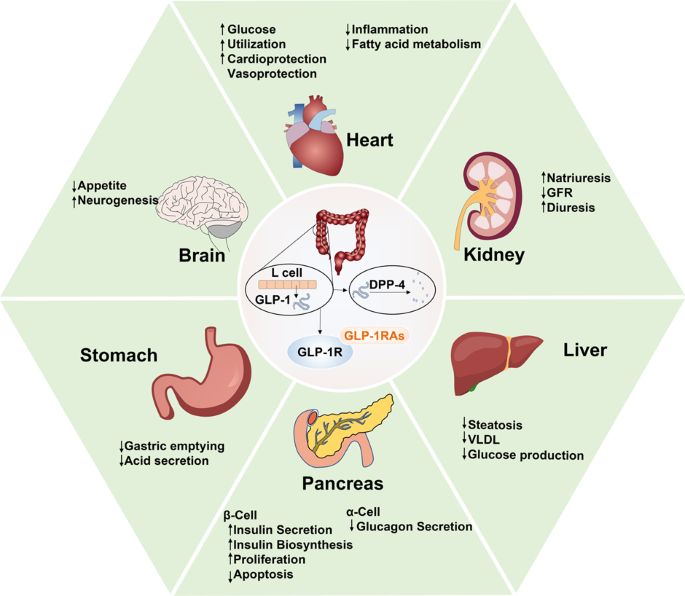From professional athletes to everyday people seeking better health, peptides are quietly becoming the body’s secret weapon. But what makes them so powerful? Peptides are small molecules composed of amino acids, and they are used as targeted signaling molecules, essentially acting as messengers that instruct cells and tissues on how to function. Because of their high specificity, they can target particular biological pathways with minimal off-target effects, which often leads to fewer side effects than traditional drugs1.
Peptide medications are often synthetic versions of natural peptides, designed to mimic their actions but often possess increased potency or duration of action.
In the early half of the 20th century, the first peptide hormone that was isolated from natural sources was insulin and ACTH.
Insulin and ACTH (adrenocorticotropic hormone) saved lives by treating diseases that were previously a death sentence. Before these peptide hormones were isolated and purified, there were no effective treatment modalities for Type 1 diabetes and Addison's disease.
Since then many peptides have been developed. The development of glucagon-like peptide-1 (GLP-1) medications and growth hormone-releasing peptides such as tesamorelin highlight a modern approach to peptide therapy: creating synthetic versions of natural peptides to achieve a more potent, stable, and targeted therapeutic effect.
Peptide therapy may be the upgrade your body has needed for a long time. Peptides provide noticeable advantages for promoting healthy aging, increasing recovery time, and sharpening focus. Find out how Vita Bella's peptide solutions may support your growth.
Bioactive Peptides
Bioactive peptides (BP) 2 consist of specific portions of proteins that positively affect physiological processes or circumstances and may have an effect on health. Till now, 1500 distinct BP have been registered in a database called "Biopep." Proteins are polypeptides with a higher molecular weight (MW). In contrast, BP are organic materials made up of amino acids connected by covalent bonds, sometimes referred to as amide or peptide bonds.
Differences between Peptides and Hormones
Peptides are needed for several metabolic reactions and are important for basic physiological functions. A peptide is a short chain of 2 to 50 amino acids 3 joined by a covalent bond and created by a condensation process. Neurotransmitters, hormones, and other physiologically active peptides are made from an RNA template that is transcribed from DNA.
Endogenous Peptides synthesized in various tissues, including the brain, gut, and immune cells, where they help modulate numerous functions. Natural and manufactured peptides have been leveraged for therapeutic and diagnostic purposes. The ability of peptides to bind with high specificity to particular receptors has made them invaluable tools in medical diagnostics and oncology.
Hormones act via intracellular or cell-surface receptors. They are secreted by endocrine glands (pituitary, adrenal, thyroid, pancreas, and gonads). Epinephrine and other peptide hormones and amino acid derivatives operate on cell-surface receptors to open ion channels, trigger fast electrical impulses, and make it easier for exocytosis of hormones or neurotransmitters 4.
The endocrine hormones are a diverse group of substances that travel through the circulation and affect distant tissues, changing the body's metabolic processes. They fall into three general categories: peptides, steroids, and tyrosine derivatives 5. They may act on intracellular or cell surface receptors.
How do peptides work in the body to promote healing, weight loss, or muscle growth?
Various peptide-based materials, including antimicrobial peptides (AMPs), cell-penetrating peptides (CPPs), angiogenic peptides, and extracellular matrix (ECM)-mimetic peptides, provide special multifunctional advantages for wound healing, such as improved angiogenesis, tissue regeneration, immunomodulation, and infection control. These peptides can be used in combination in a single material, such as a hydrogel, providing a "multifunctional" advantage. Several companies are in fact developing these products with the hopes that they could simultaneously fight infection (AMPs), promote the growth of new blood vessels (angiogenic peptides), deliver therapeutic agents into cells (CPPs), and provide a supportive scaffold for new tissue growth (ECM-mimetic peptides).
Promote Healing
Peptides' antibacterial, angiogenic, and anti-inflammatory properties hasten the healing of wounds 6.
AMPs stimulate keratinocyte migration and have antibacterial action.
Hydrogels, nanofibers, and functionalised dressings based on peptides have been developed for therapeutic purposes.
Weight loss
A rising public health concern; obesity raises the risk of osteoarthritis, heart disease, and type 2 diabetes.
Glucagon-like peptide 1 receptor agonists, or GLP-1RAs, are a class of drugs that were first created to treat type 2 diabetes but are now also being used to treat obesity or weight loss 7. However, losing weight may lower the chance of getting health issues.
Liraglutide, or GLP-1s, has been approved for the treatment of obesity, whereas semaglutide is undergoing clinical testing.
GLP-1s function by decreasing hunger and appetite, delaying the stomach's food release, and raising sensations of fullness after meals.
Muscle growth
To combat sarcopenia, substances that boost muscle mass 8 and encourage anabolic pathways may be beneficial.
Among them, several anabolic pathways in skeletal muscle have been linked to the insulin-like growth factor-1 (IGF-1).
There are several isoforms of IGF-1, and each may have a distinct function in skeletal muscle.
Insulin-like growth factor 1 (IGF-1) is a key player in the growth of muscles, differentiation, and rejuvenation among the pathways that control protein turnover and muscle function.
Peptides are being developed to target myostatin, a protein that acts as a negative regulator of muscle growth. By inhibiting myostatin, these peptides aim to increase muscle mass and strength, particularly for treating muscle-wasting diseases like muscular dystrophy and sarcopenia.

Image source: Research paper
Safety and legality of Peptides
Peptide development and safety evaluation 9 face a number of challenges, much like any other technology. Additionally, this sector mostly relies on linking existing small molecule and biologic guidelines because there is not enough particular regulatory guidance for peptide development.
Many therapeutic peptides are candidates undergoing preclinical 10 (~600) and clinical (~200) testing to determine their safety and effectiveness in treating different illnesses. Immunogenicity can lead to the creation of antidrug antibodies (ADAs), which might limit how well the treatment works and its safety in clinical trials.
That's why the European Medicines Agency (EMA) and the Food and Drug Administration (FDA) have established criteria for evaluating hazards in market authorisation applications. These recommendations include determining the immunogenicity and purity levels of peptides.
From Tired to Thriving: The Power of Peptide Therapy
Are you struggling with low energy, slow recovery, or persistent health challenges? You don’t have to settle for “just the way it is.” Peptide therapy works at the cellular level to repair, restore, and recharge your body. With Vita Bella’s cutting-edge peptide solutions, you can feel sharper, stronger, and more in control of your health than ever before.
Peptides are more than just buzzwords; they’re powerful messengers in your body that help heal, restore, and optimize daily function. Peptide therapy taps into this natural system to support muscle growth, recovery, weight management, and healthy aging.
FAQs
1. What exactly are peptides, and how are they different from proteins?
Peptides are short chains of amino acids, smaller than proteins, and act as signalling molecules in the body. While proteins perform structural and functional roles, peptides primarily regulate biological processes, making them powerful tools in therapy.
2. What conditions or goals can peptide therapy help with?
Peptide therapy has shown benefits in muscle recovery, skin rejuvenation, hormone balance, weight management, cognitive health, immune support, and healthy aging. Depending on the peptide, it can target very specific functions in the body.
3. Is peptide therapy safe, and how is it administered?
Yes, when prescribed by a qualified healthcare provider, peptide therapy is considered safe. It can be administered through injections, capsules, creams, or nasal sprays, depending on the treatment plan. Safety and results improve when therapies are science-backed, like those offered by Vita Bella.





















